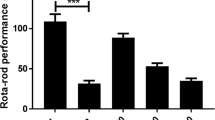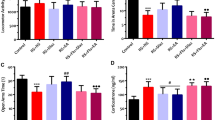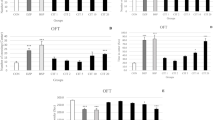Abstract
The current study was designed with the aim to investigate anti-anxiety potential of Hibiscus rosa sinensis roots and its possible mechanism of action. For this purpose hole board test, elevated plus maze test and light/dark exploration test were employed. The ethanol extract of plant was administered orally at two different doses i.e. 100 and 500 mg/kg for consecutive 14 days. The results of present investigation indicate that plant extract significantly (p < 0.05) increased the number of head dips and rearings as compared to control on respective days of observation. The extract increased the time of permanence in open arms and the number of head dips in elevated plus maze. In light/dark test, our study indicate that Hibiscus rosa sinensis significantly (p < 0.05) increased the time spent in light compartment and number of entries as compared to control. In addition the anxiolytic effects of HRS at highest tested dose were blocked by flumazenil, a GABA-A receptor antagonist that indicate that Hibiscus rosa sinensis potentiated the GABAergic actions. The results propose that the ethanol extract of Hibiscus rosa sinensis has prospective anxiolytic effect in mice via inhibition of ionotropic GABA receptors, using different behavioral paradigms.
Similar content being viewed by others
References
Adeyemi OO, Yetmitan OK, Taiwo AE (2006) Neurosedative and muscle relaxant activities of ethyl acetate extract of Baphia nitida Afzel. J Ethnopharmacol 106:312–316
Alan JG (2000) Psychiatric and Somatic Markers of Anxiety: Identification and Pharmacologic Treatment. Prim Care Comp J Clin Psychiatry 2:49–54
Ballinger BR (1990) New drugs. Hypnotics Anxiolytics Br Med J 300:456–458
Bhatacharya SK, Satyan KS (1997) Experimental methods for evaluation of psychotropic agents in rodents: Anti-anxiety agents. Indian J Exp Biol 35:565–575
CSIR: The Wealth of India. A Dictionary of Indian Raw Materials and Industrial Products. New Delhi, Council for Scientific and Industrial Research, 1956: pp. 91–92.;
Dhonnchadha BA, Bourin M, Hascoet M (2003) Anxiolytic- like effects of 5-HT 2 ligands on three mouse models of anxiety. Behav Brain Res 140:203–214
Gillian RB, Christopher N (2008) The exploratory behaviour of rats in the hole-board apparatus: is head-dipping a valid measure of neophilia? Behav Process 78(3):442–448.
Hellion-Ibarrola MC, Ibarrola DA, Montalbetti Y, Kennedy ML, Heinichen O, Campuzano M et al (2006) The anxiolytic-like effects of Aloysia polystachya (Griseb) Moldenke (Verbenaceae) in mice. J Ethnopharmacol 105:400–408
Holm M (1988) Prescription of benzodiazepines in general practice in the county of Arhus, Denmark. Dan Med Bull 35(4):95–99
Jain NN, Ohal CC, Shroff RH, Somani RS, Kasture VS, Kasture SB (2003) Clitoria ternatea and the CNS. Pharmacol Biochem Behav 75:529–536
Johnston JM, Foxx RM, Jacobson JW, Green G, Mulick JA (2006) Positive behavior support and applied behavior analysis. Behavior Analyst 29:51–74
Jordan AD, Kordik CP, Reitz AB, Sanfillipo PJ (1996) Novel anxiolytic agents- 1994 to present. Expert Opinion Thera Pat 6:1047–1060
Masaki HS, Sakaki S, Atsumi T, Sakurai H (1995) Biol Pharmacol Bull 18:162–166
Mhaskar KS, Blatter E, Calus JF. (2000) Kirtikar and Basu illustrated Indian Medicinal Plants, Vol. II, Shri Satguru Publication, New Delhi; 462–464
Nemeroff CB (2007) The burden of severe depression: a review of diagnositic Challenges and treatment alternatives. J Psychiatr Res 41:189–206
Rang HP, Dale MM, Ritter JN (2003) Pharmacology: Churchill Livingstone. 483–94
Robert L. D Pont, DP Rice, LS Miller, SS Shiraki, CR Rowland, HJ Harwood (1996) 2 (Issue 4):167–17
Singh N, Nath R, Agarwal AK, Kohli RP (1978) Yoga Homeopathy. J Res Indian Med 13:58–62
Sonavane GS, Sarveiya VP, Kasture VS, Kasture SB (2002) Anxiogenic activity of Myristica fragrans seeds. Pharmacol Biochem Behav 71:239–244
Thakur VD, Mengi SA (2005) Neuropharmacological profile of Eclipta Alba L. Hassk. J Ethnopharmacol 102:23–31
Yadav AV, Kawale LA, Nade VS (2008) Effect of Morus Alba L. (mulberry) leaves on anxiety in mice. Indian J Pharm 40(1):32–36
Younus I, Siddiq A (2017) Behavioral evidence of antidepressant-like activity of Raphanus sativus L. Var. caudatus in mice. African J Tradit Complement Altern Med 14.3:142
Acknowledgements
Authors would like to acknowledge Hamdard University Research Committee (HURC) for providing research grant to conduct this piece of work.
Author information
Authors and Affiliations
Corresponding author
Ethics declarations
Conflict of interest
None
Ethical approval
The ethical clearance of present study was approved by Ethical Review Board (ERB) of Hamdard University (No. ERB-16-01, dated 29–04-2016). Specifications described in Helsinki Resolution 1964 were adopted for animal handling in this research.
Rights and permissions
About this article
Cite this article
Begum, Z., Younus, I. Hibiscus rosa sinensis mediate anxiolytic effect via modulation of ionotropic GABA-A receptors: possible mechanism of action. Metab Brain Dis 33, 823–827 (2018). https://doi.org/10.1007/s11011-018-0188-4
Received:
Accepted:
Published:
Issue Date:
DOI: https://doi.org/10.1007/s11011-018-0188-4




